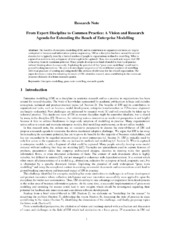From expert discipline to common practice: a vision and research agenda for extending the reach of enterprise modeling
Sandkuhl, Kurt; Fill, Hans-Georg; Hoppenbrouwers, Stijn; Krogstie, John; Matthes, Florian; Opdahl, Andreas Lothe; Schwabe, Gerhard; Uludag, Ömer; Winter, Robert
Peer reviewed, Journal article
Accepted version
Permanent lenke
http://hdl.handle.net/1956/19721Utgivelsesdato
2018-02Metadata
Vis full innførselSamlinger
Originalversjon
https://doi.org/10.1007/s12599-017-0516-ySammendrag
The benefits of enterprise modeling (EM) and its contribution to organizational tasks are largely undisputed in business and information systems engineering. EM as a discipline has been around for several decades but is typically performed by a limited number of people in organizations with an affinity to modeling. What is captured in models is only a fragment of what ought to be captured. Thus, this research note argues that EM is far from its maximum potential. Many people develop some kind of model in their local practice without thinking about it consciously. Exploiting the potential of this “grass roots modeling” could lead to groundbreaking innovations. The aim is to investigate integration of the established practices of modeling with local practices of creating and using model-like artifacts of relevance for the overall organization. The paper develops a vision for extending the reach of EM, identifies research areas contributing to the vision and proposes elements of a future research agenda.
